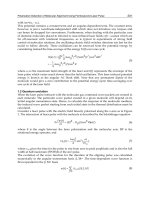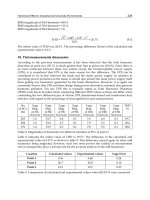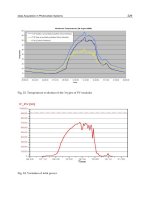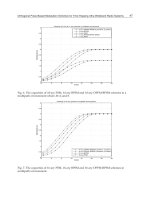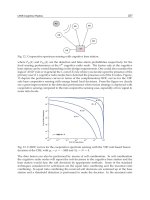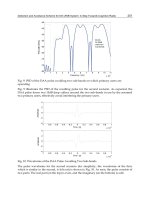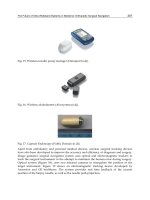Applications of High Tc Superconductivity Part 13 potx
Bạn đang xem bản rút gọn của tài liệu. Xem và tải ngay bản đầy đủ của tài liệu tại đây (2.33 MB, 20 trang )
Preparation of Existing and Novel Superconductors using a Spatial Composition Spread Approach
229
magnitude in going from cubic CeIn
3
to its tetragonal analogues CeMIn
5
(M = Rh, Ir or Co)
as anticipated by the magnetic interaction model (Monthoux & Lonzarich, 2002). Thus in the
search for higher temperature superconductors one should explore the border of
antiferromagnetism in a quasi two-dimensional tetragonal system with high characteristic
spin fluctuation frequencies.
The conditions favourable for magnetic pairing include: (i) strong quasi two-dimensional
antiferromagnetic correlations (large J) for spin singlet pairing and for large amplitude
oscillations of the spin-spin interaction (gives small correlation length ξ which is inversely
proportional to T
c
), (ii) a single band of relatively high characteristic energy scale, and (iii) a
crystal structure that enables the repulsive regions of the pairing potential to be optimally
neutralized. Favourable T
c
‘s can be achieved in layered d-electron systems of moderate
electron densities (n) and bandwidths (t) and can be controlled by chemical doping or
hydrostatic pressure (Monthoux et al, 2007).
One system which satisfies most of these requirements is the perovskite-type single layer
compounds of composition A
2
MX
4
and double layer compounds of composition A
3
M
2
X
7
,
where A
1+
= K, Rb, Cs, M
2+
= Mg, Mn, Fe, Co, Cu, Cd
and X = F, Cl , or Br (see Geick, 2001
for a review). In these perovskite-type layer structures the dominant magnetic interaction is
the nearest-neighbour Heisenberg exchange within the layers which causes their 2D
character. These compounds have a metal ion (M) surrounded by 6 halides (X) in an
octahedral arrangement. The magnetic properties depend on the intralayer superexchange
interaction (J) mediated by the halide (X) between two M ions. Theory predicts an
exponential dependence of J on the nearest neighbour distance (a
MXM
) and experiments find
a power law dependence J(a
nn
) = J(a
nn,0
)(a
nn
/a
nn,0
)
-12
for small a
nn
.
A classic perovskite layer compound is La
2
CuO
4
(X = O
2-
, M = Cu
2+
, and A = La
2+
) which
when appropriately doped (e.g. hole doped by replacing Sr
2+
for La
3+
or electron doped by
replacing La
3+
with Nd
3+
and doping with Ce
3+,4+
) forms a high temperature superconductor.
It must be noted that a priori one could not have predicted these dopings would produce
superconductivity. La
2
CuO
4
has AFM order in-plane and out of plane and it is thought that
superconductivity above liquid helium temperatures are possible because of (a) the large
exchange interaction J/k
B
~ 766 K (Hayden et al, 1991); and (b) that the electrons in the Cu
d
x
2
-y
2
band possesses the correct symmetry to avoid Coulomb repulsion.
In looking for promising hosts, the single layer K
2
CuF
4
and double layer K
3
Cu
2
F
7
compounds seem to have the right structure, and the d-band of Cu is the highest partially
filled band. However, the intralayer interaction is small (J/k
B
= 11K), produces
ferromagnetic order (Feldkemper et al, 1995) and the Cu
2+
ions exhibit alternating
occupation of z
2
- x
2
and z
2
- y
2
hole states unlike the x
2
- y
2
ordering in La
2
CuO
4
(Fig. 11).
However, by inducing distortive changes at pressures larger than 9.5 GPa in the basal plane
of the CuF
6
octahedra (Ishizuka et al, 1996; Ishizuka et al, 1998) was able to obtain (Fig. 12)
antiferromagnetic order in K
2
CuF
4
with x
2
- y
2
hole orbital overlap, exactly as found in the
prototype cuprate superconductor La
2
CuO
4
.
SCAN PHASE SPACE: Since the high pressure phase of K
2
CuF
4
is so similar to La
2
CuO
4
in
its orbital ordering, structure and magnetic properties, it satisfies the conditions set out by
Monthoux and Lonzarich and should become a superconductor when appropriately doped.
To obtain the high pressure phase of K
2
CuF
4
one may attempt (a) pseudomorphic growth of
Applications of High-Tc Superconductivity
230
Fig. 11. The two kinds or orbital ordering in the basal plane of a K
2
NiF
4
-type compound. (a)
Antiferrodistortive orbital ordering of d
x
2
-
z
2
and d
y
2
-
z
2
in K
2
CuF
4
and (b) Ferrodistortive
orbital ordering of d
x
2
-
y
2
in La
2
CuO
4
. In (a) the CuO
6
octahedra elongate alternately along a-
and b-axis whereas it elongates along the c-axis only in (b). (from Ishizuka et al, 1996).
films onto substrates which produce compressive strain. The M-X-M distance in K
2
CuF
4
is ~
4.124 Å. Therefore, SrLaAlO
4
(3.756 Å, -10%), SrTiO3 (3.905 Å, -6%), LaAlO
3
(3.821 Å, -8%)
and SrLaGaO
4
(3.843 Å, -8%) substrates should all produce compressive strain, while MgO
(a = 4.212 Å, +1%) should produce tensile strain in epitaxial films. It must be noted that film
stresses of more than 10 GPa have been achieved in pseudomorphic Fe layers (Sander, 1999).
Epitaxial films of the cuprate superconductors sometimes show enhanced T
c
perhaps
because of the increase in J. One may also (b) dope smaller cations (Na
+
, Li
+
) to create
pressure by cation substitution. Substrate or cation-induced decreases in the nearest
neighbour M-X-M distances should also exponentially enhance the intra-layer interaction. In
addition, we plan to replace the fluorine anion with other halides (Cl , Br , I ) to enhance our
understanding of the effect of the exchange interaction on the appearance of
superconductivity in the films.
Preparation of Existing and Novel Superconductors using a Spatial Composition Spread Approach
231
Fig. 12. The structures of K
2
CuF
4
in (a) the high pressure phase (P>8GPa), and (b) at ambient
pressure (from Ishizuka et al, 1998).
As pointed out earlier, it is difficult to predict a priori which doping would produce
superconductivity, even when you’ve selected the right host. This is where the use of
combinatorial methods to explore phase space rapidly and efficiently becomes a great
asset. One should be able to replace K with higher valent cations C = Mg, Ca, Sr, Ba
or Y,
La
to introduce carriers and produce the phases K
2-x
C
x
CuF
4
(0<x<2). Our 52-sample mask
produces 52 unique compositions to be tested. In addition, K may be replaced with other
alkali elements (A = Na, Li, Rb, Cs) at the same time to yield (K
1-y
A
y
)
2-x
C
x
CuF
4
phases
(0<y<1, 0<x<2), which ultimately produces 52 x 52 = 2,704 unique compositions in one
experiment. Every phase can then be tested for superconductivity using a high
throughput resistivity apparatus. The full composition range of a pair of substituents (A,
C) can be deposited in one sputtering run. Where superconductivity is found one can then
explore phase space in the interesting region at higher density, followed by conventional
solid state reaction techniques to produce the bulk phases. For every pair of elements A (5
choices) and C (6 choices) 2,704 unique compositions are created. With 30 different dopant
pairs A-C we therefore produce 81,120 unique phases. If we have chosen the right host the
probability of finding a superconductor should be nonzero. Assuming a very conservative
0.1% probability of finding superconductivity one should discover 81 superconducting
phases. Each dopant pair requires at least 3 months to investigate fully, so 7.5 years are
required to cover 30 pairs. Paul Canfield (Ames Lab and Iowa State U.) said (Canfield,
2008), “In deference to the term ‘fishing trip’, a real fisherman goes where the fish are
known to congregate and reaps an abundant harvest.” By casting our net wide, in the
right host, it is very likely that the exploration described here will discover novel
superconducting phases.
Applications of High-Tc Superconductivity
232
5. Conclusions
New materials form the basis of new products which drive economic development.
Superconducting materials have held great promise for some time because they pass a
current without resistance and expel magnetic fields. These properties make them the
most sensitive magnetic sensors, best source of large magnetic fields (e.g. for use in
medical imaging - MRI), most efficient transmisson lines; and are a leading candidate for
high speed quantum computers (B. G. Levi, 2009). However, they have not found
widespread application mainly because the materials require cooling to at least -136
degrees C. Finding materials that superconduct at much higher temperatures is now
thought to be a realistic goal with the recent discovery of superconductivityin iron
arsenide based materials, the observation that a number of superconductors are doped
antiferromagnets, and the tremendous progress researchers have made in understanding
the physical properties of existing superconductors. These developments have re-ignited
the field by offering a path to novel superconductors - explore the transport properties of
doped antiferromagnets.
To explore the properties of a large number of samples, a spatial composition spread
approach has been developed at Dalhousie to more quickly and efficiently prepare new
materials. In a single experiment hundreds of compositions can be studied, whereas a serial
preparation approach would take several years. We have described in this chapter the
feasibility of the approach to densely map the physical properties of an existing
superconductor, La
2-x
Sr
x
CuO
4
. To identify novel superconductors, we have proposed that
layered fluoride perovskite compounds be screened using the high-throughput resistivity
apparatus developed in our labs. To enhance our understanding of existing
superconductors we have also shown that the phase diagram can be mapped at very high
density to deduce the doping dependence of a feature, the pseudogap onset temperature,
which helps determine the class of theories that apply to the cuprate superconductors.
6. Acknowledgements
We acknowledge the financial support of the Natural Science and Enginnering Research
council of Canada, and use of the facilities of the Institute for Research in Materials. We also
acknowledge recent fruitful discussion with Paul Canfield during a recent visit to
Dalhousie.
7. References
Ando, Y., Komiya, S., Segawa, K., Ono, S., & Kurita, Y. (2004). Electronic phase diagram of
high-T
c
superconductors from mapping of the in-plane resistivity curvature. Phys.
Rev. Lett., Vol. 93, No. 26, (December 2004), pp. 267001-1-4, ISSN 0031-9007
Arvanitidis, J., Papagelis, K., Takabayashi, Y., Takenobu, T., Iwasa, Y., Rosseinsky, M. J., &
Prassides, K. (2007). Magnetic ordering in the ammoniated alkali fullerides
(NH
3
)K
3-x
Rb
x
C
60
(x=2,3). J. Phys.: Condens. Matter, Vol. 19, No. 38, (September
2007), pp. 386235-1-13, ISSN 0953-8984
Preparation of Existing and Novel Superconductors using a Spatial Composition Spread Approach
233
Canfield, P. C. (2008) Fishing the Fermi sea. Nature Physics, Vol. 4, No. 3, (March 2008), pp.
167-169, ISSN 1745-2473
Chen, H., Ren, Y., Qiu, Y., Bao, W., Liu, R. H., Wu, G., Wu, T., Xie, Y. L., Wang, X. F., Huang,
Q. & Chen X. H. (2009). Coexistence of of the spin-density wave and
superconductivity in Ba
1-x
K
x
Fe
2
As
2
. Europhys. Lett., Vol. 85, No. 17006, (January
2009), pp. 17006-p1-p5, ISSN 0295-5075
Cho, A. (2006). High-T
c
: The mystery that defies solution. Science, Vol. 314, No. 5802, pp.
1072-1075, ISSN 0036-8075
Choy, T P., Leigh, R. G., & Phillips, P. (2008). Hidden charge-2e boson: Experimental
consequences for doped Mott insulators. Phys. Rev. B, Vol. 77, No. 10, (March
2008), pp. 104524-1-9, ISSN 1098-0121
Dahn, J. R., Trussler, S., Hatchard, T. D., Bonakdarpour, A., Mueller-Neuhaus, J. R., Hewitt,
K. C., & Fleischauer, M. (2002). Economical Sputtering system to produce large-size
composition-spread libraries having linear and orthogonal stoichiometry
variations. Chem. Mater., Vol. 14, No. 8, (July 2002), pp. 3519-3523, ISSN 0897-4756
Drew, A. J., Niedermeyer, C., Baker, P. J., Pratt, F. L., Blundell, S. J., Lancaster, T., Liu, R. H.,
Wu, G., Chen, X. H., Watanabe, I., Malik, V. K., Dubroka, A., Rossie, M., Kim, K.
W., Baines, C., & Bernhard, C. (2009). Coexistence of static magnetism and
superconductivity in SmFeAsO
1-x
F
x
as revealed by muon spin rotation. Nature
Materials, Vol. 8, No. 4, (April 2009), pp. 310-314, ISSN 1476-1122
Feldkemper, S., Weber, W., Schulenburg, J., Richter, J. (1995). Ferromagnetic coupling in
non-metallic Cu
2+
compounds. Phys. Rev. B, Vol. 52, No. 1, (July 1995), pp. 313-323,
ISSN 0163-1829
Foo, M. L., Wang, Y. Y., Watauchi, S., Zandbergen, H. W., He, T., Cava, R. J., Ong, N. P.
(2004). Charge ordering, commensurability, and metallicity in the phase diagram of
the layered Na
x
CoO
2
. Phys. Rev. Lett., Vol. 92, No. 24, (June 2004), pp. 247001-1-4,
ISSN 0031-9007
Geick, R. (2001). Halide Perovskite-type Layer Structures (Subvolume J3), In:. Group III:
Condensed Matter – Volume 27, Magnetic Properties of Non-Metallic Inorganic
compounds based on transition elements (Landolt-Börnstein: Numerical Data and
Functional Relationships in Science and Technology), H. P. J. Wijn, pp. 159-161, 188-190,
254, Springer-Verlag, ISBN 1616-9549, Berlin, Germany
Hayden, S. M., Aeppli, G., Osborn, R., Taylor, A. D., Perring, T. G., Cheong, S. W., Fisk, Z.
(1991). High energy spin waves in La
2
CuO
4
. Phys. Rev. Lett., Vol. 67, No. 25,
(December 1991), pp. 3622-3625, ISSN 0031-9007
Hewitt, K. C., Casey, P. A., Sanderson, R. J., White, M. A. & Sun, R (2005). High-throughput
resistivity apparatus for thin-film combinatorial libraries. Rev. Sci. Instrum., Vol.
76, No. 9, (September 2005), pp. 093906-1-9, ISSN 0034-6748
Hubbard, J. (1963). Electron correlations in narrow energy bands. Proc. Roy. Soc. Lon. A, Vol.
276, No. 1365, (November 1963), pp. 257, ISSN
Imai, T., Ahilan, K., Ning, F. L., McQueen, T. M., Cava, R. J. (2009). Why does undoped FeSe
become a high-T
c
superconductor under pressure? Phys. Rev. Lett., Vol. 102, No. 17,
(May 2009), pp. 177005-1-4, ISSN 0031-9007
Applications of High-Tc Superconductivity
234
Ishizuka, M., Yamada, I., Amaya, K., & Endo, S. (1996). Change of magnetism in the two-
dimensional Heisenberg ferromagnet K
2
CuF
4
observed at high pressure. J. Phys.
Soc. Jpn., Vol. 65, No. 7, (July 1996), pp. 1927-1929, ISSN 0031-9015
Ishizuka, M. Terai, M., Endo, S., Hidaka, M., Yamada, I., & Shimomura, O. (1998). Pressure
induced phase transition in the two-dimensional Heisenberg ferromagnet K
2
CuF
4
.
J. Magn. Mag. Mater., Vol. 177, No. 1, (January 1998), pp. 725-726, ISSN 0304-8853
Kennedy, K., Stefansky, T. Davy, G., Zakay, V. F. & Parker, E. R. (1965). Rapid Method for
determining ternary-alloy phase diagrams. J. Appl. Phys., Vol. 36, No. 12,
(December 1965), pp. 3808-3810, ISSN 0021-8979
Kuiper, P., Kruizinga, G., Ghijsen, J., Grioni, M., Weijs, P. J. W., de Groot, F. M. F., Sawatzky,
G. A., Verweij, H., Feiner, L. F., & Petersen, H. (1988). X-ray absorption study of the
O 2p hole concentration dependence on O stoichiometry in YBa
2
Cu
3
O
x
. Phys. Rev.
B, Vol. 38, No. 10, (October 1988), pp. 6483-6489, ISSN 0163-1829
Leigh, R. G., Phillips, P., & Choy, T. P. (2007). Hidden charge 2e boson in doped Mott
insulators. Phys. Rev. Lett., Vol. 99, No. 4, (July 2007), pp. 046404-1-4, ISSN 0031-
9007
Levi, B. G. (2009). Superconducting qubit systems come of age. Physics Today, Vol. 62, No.
7, (July 2009), pp. 14-16, ISSN 0031-9228
Logvenov, G., Sveklo, I., & Bozovic, I. (2007). Combinatorial molecular beam epitaxy of
La
2-x
Sr
x
CuO
4+
δ
. Physica C, Vol. 460, (September 2007), pp. 416-419, ISSN 0921-
4534
Luetkens, H., Klaus, H. H., Kraken, M., Litterst, F. J., Dellmann, T., Klingeler, R., Hess, C.,
Khasanov, R., Amato, A., Baines, C., Kosmala, M., Schumann, O. J., Braden, M.,
Hamann-Borrero, J., Leps, N., Kondrat, A., Behr, G., Werner, J., & Buchner, B.
(2009). The electronic phase diagram of the LaO
1-x
F
x
FeAs superconductor. Nature
Materials, Vol. 8, No. 4, (April 2009), pp. 305-309, ISSN 1476-1122
Monthoux, P. & Lonzarich, G. G. (1999) p-wave and d-wave superconductivity in quasi-
two-dimensional metals. Phys. Rev. B, Vol. 59, No. 22, (June 1999), pp. 14598-14605,
ISSN 0163-1829
Monthoux, P., & Lonzarich, G. G. (2001). Magnetically mediated superconductivity in
quasi-two and three dimensions. Phys. Rev. B, Vol. 63, No. 5, (February 2001), pp.
054529-1-10, ISSN 0163-1829
Monthoux, P, Pines, D., Lonzarich, G. G. (2007). Superconductivity without phonons.
Nature, Vol. 450, No. 7173, (December 2007), pp. 1177-1183, ISSN 0028-0836
Monthoux, P, & Lonzarich, G. G. (2002). Magnetically mediated superconductivity:
Crossover from cubic to tetragonal lattice. Phys. Rev. B, Vol. 66, No. 22, (December
2002), pp. 224504-1-8, ISSN 1098-0121
Mott, N. (1968) Metal-Insulator Transitions. Rev. Mod. Phys., Vol. 40, No. 4, (October 1968),
pp. 677-683
Norman, M. R., Pines, D., & Kallin, C. (2005). The Pseudogap: friend or foe of high T
c
?
Advances in Physics, Vol. 54, No. 8, (December 2005), pp. 715-733, ISSN 0001-8732
Petrovic, C., Pagliuso, P. G., Hundley, M. F., Movshovich, R., Sarrao, J. L., Thompson, J. D.,
Fisk, Z., & Monthoux, P. (2001). Heavy-fermion superconductivity in CeCoIn
5
at 2.3
Preparation of Existing and Novel Superconductors using a Spatial Composition Spread Approach
235
K. J. Phys.:Condens. Mat., Vol. 13, No. 17, (April 2001), pp. L337-L342, ISSN 0953-
8984
Saadat, M., George, A. E., & Hewitt, K. C. (2010). Densely mapping the phase diagram of
cuprate superconductors using a spatial composition spread approach. Physica C,
Vol. 470, No. Sp. Iss. SI Suppl. 1, (December 2010), pp. S59-S61, ISSN 0921-4534
Sander, D. (1999). The correlation between mechanical stress and magnetic anisotropy in
ultrathin films. Rep. Prog. Phys., Vol. 62, No. 5, (May 1999), pp. 809-858, ISSN 0034-
4885
Sanderson, R. J. & Hewitt, K. C. (2007). Magnetron sputter deposition of a 48-member
cuprate superconductor library: Bi
2
Sr
2
Y
x
Ca
1-x
Cu
2
O
8+
δ
(0.5 ≤ x ≤ 1) linearly varying
in steps of Δx = 0.01. Appl. Surf. Sci., Vol. 254, No. 3, (November 2007), pp. 760-764,
ISSN 0169-4332
Sanderson, R. J. & Hewitt, K. C. (2005) Stoichiometry control of magnetron sputtered
Bi
2
Sr
2
Ca
1-x
Y
x
Cu
2
O
y
(0 ≤ x ≤ 0.5), thin film, composition spread libraries: Substrate
bias and gas density factors. Physica C, Vol. 425, No. 1-2, (September 2005), pp. 52-
61, ISSN 0921-4534
Scalapino, D. J. 9
th
International Conference on Materials and Mechanism of
Superconductivity. Tokyo, Japan, Sept. 10 (2009)
Takabayashi, Y., Ganin, A. Y., Jeglic, P., Arcon, D., Takano, T., Iwasa, Y., Ohishi, Y.,
Takata, M., Takeshite, N., Prassides, K., & Rosseinsky, M. J. (2009). The Disorder-
free non-BCS superconductor Cs
3
C
60
emerges from an antiferromagnetic
insulator parent state. Science, Vol. 323, No. 5921, (March 2009), pp. 1585-1590,
ISSN 0036-8075
Takada, K., Sakurai, H., Takayama-Muromachi, E., Izumi, F., Dilanian, R. A., & Sasaki, T.
(2003). Superconductivity in two-dimensional CoO
2
layers. Nature, Vol. 422, No.
6927, (March 2003), pp. 53-55, ISSN 0028-0836
Timusk, T. & Statt, B. (1999). The Pseudogap in high-temperature superconductors: An
experimental survey. Rep. Prog. Phys., Vol. 62, No. 1, (January 1999), pp. 61-122,
ISSN 0034-4885
Tranquada, J. M., Sternlieb, B. J., Axe, J. D., Nakamura, Y., & Uchida, S. (1995). Evidence for
stripe correlations of spins and holes in copper-oxide superconductors. Nature, Vol.
375, No. 6532, (June 1995), pp. 561-563, ISSN 0028-0836
Uemura, Y. J. (2009). Commonalities in phase and mode. Nature Materials, Vol. 8, No. 4,
(April 2009), pp. 253-255, ISSN 1476-1122
Van Dover, R. B., Schneemeyer, L. F., & Fleming, R. M. (1998). Discovery of a useful thin-
film dielectric using a composition-spread approach. Nature, Vol. 392, No. 6672,
(March 1998), pp. 162-164, ISSN 0028-0836
Xiang, X. D., Sun, X D., Briceno, G., Lou, Y. L., Wang, K. A., Chang, H. Y.,
Wallacefreedman, W. G., Chen, S. W., & Schultz, P. G. (1995). A Combinatorial
approach to materials discovery. Science, Vol. 268, No. 5218, (June 1995), pp. 1738-
1740, ISSN 0036-8075
Xiang, X-D. (1999). Combinatorial materials synthesis and screening: An integrated
materials chip approach to discovery and optimization of functional materials.
Annu. Rev. Mater. Sci., Vol. 29, pp. 149-171, ISSN 0084-6600
Applications of High-Tc Superconductivity
236
Zhao, J., Huang, Q., de la Cruz, C., Li, S. L., Lynn, J. W., Chen, Y., Green, M. A., Chen, G. F.,
Li, G., Li, Z., Luo, J. L., Wang, N. L., & Dai, P. C. (2008). Structural and Magnetic
phase diagram of CeFeAsO
1-x
F
x
and its relation to high-temperature
superconductivity. Nature Materials, Vol. 7, No. 12, (December 2008), pp. 953-959,
ISSN 1476-1122.
12
Superhard Superconductive
Composite Materials Obtained by
High-Pressure-High-Temperature Sintering
Sergei Buga, Gennadii Dubitsky, Nadezhda Serebryanaya,
Vladimir Kulbachinskii and Vladimir Blank
Technological Institute for Superhard and Novel Carbon Materials,
Ministry of Education and Science of the Russian Federation
Russian Federation
1. Introduction
Superhard superconducting materials are of considerable interest for the creation of high
pressure devices for investigating electrical and superconducting properties of various
materials. The superconducting composites consisting of superconductors and superhard
materials that are in thermal and electrical contacts may satisfy very conflicting
requirements imposed on superconducting materials for special research cryogenic
technique, wear-resistive parts of superconductor devices, superconducting micro-electro-
mechanical systems (MEMS), etc. The design of materials combining such properties as
superconductivity, superhardness, and high strength is an interesting task for both scientific
and applied reasons. Superconducting composites may be used for the production of large
superconducting magnetic systems (Gurevich et al., 1987).
The discovery of superconductivity in heavily boron-doped diamonds (Ekimov et al., 2004;
Sidorov et al., 2005) has attracted much attention. Superconducting diamonds are the
hardest known superconductors. The potential applications of superconducting diamonds
are broad, ranging from anvils in research high-pressure apparatus to supecronducting
MEMS. However, the highest value of the superconductivity onset temperature in boron-
doped diamonds was found just about 7 K in thin CVD-grown films (Takano et al., 2004)
and at about 4 K in bulk diamonds grown at high-pressure and high-temperature (Ekimov
et al., 2004; Sidorov et al., 2005). In these pioneering works bulk polycrystalline diamonds
with micron grainsize have been synthesized from graphite and B
4
C composition (Ekimov
et al., 2004) and graphite with 4 wt% amorphous boron (Sidorov et al., 2005). The synthesis
have been carried out at 8-9 GPa pressure and 2500-2800 K temperature in both cases. Later
Dubrovinskaya et al., 2006, carried out synthesis of graphite with B
4
C composition at much
higher pressure value 20 GPa but the same temperature of 2700K and found the
superconducting state transition at lower temperature 2.4 - 1.4 K in the obtained doped
polycrystalline diamonds. Due to the sharpening of the temperature interval of the
superconductivity transition in magnetic field they suggested that superconductivity could
arise from filaments of zero-resistant material. An alternative method for the creation of
composite diamond superconductors was suggested by one of the authors of the present
Applications of High-Tc Superconductivity
238
article, G. Dubitsky, who used sintering of diamond powders with molybdenum to fabricate
special research high-pressure anvils with T
C
= 10 K (Narozhnyi et al., 1988). Such a unique
high-strength superconducting anvils for research high-pressure apparatus were employed
for investigations of the pressure effect up to 22 GPa on the superconductor transition
temperatures in the metallic high-pressure phase of GaP. Modern technologies for large-
scale industrial powder diamonds and cubic boron nitride manufacturing provide an easy
opportunity to produce a wide range of superhard sintered superconductors with various
mechanical and electronic properties.
By sintering diamond micropowders with metal powders (Nb, Mo) and using metal-coated
diamond micropowders at high static pressure and temperature we obtained superhard
superconductors with T
C
substantially higher than in boron-doped diamonds (Dubitsky et
al., 2005, 2006). Interacting with diamond, Nb and Mo metals form carbides bonding
diamond crystallites into a united compact material having relatively high critical
temperatures of the transition to the superconducting state.
The alternative route is the sintering of superconductor powders with superhard fullerites -
new carbon materials produced from C
60
and C
70
fullerenes (Blank et al., 1998, 2006). Under
high pressure and temperature treatment soft C
60
and C
70
powders transform into fullerene
polymers and other carbon structures with various hardness including superhard and even
superior to diamond. There are known many alkali metal-fullerene superconductors with
relatively high T
C
up to about 30K (Holczer & Whetten, 1993, Kulbachinskii, 2004,
Kulbachinskii et al., 2008). However alkali metal-fullerenes react with oxygen when exposed
to air. Sintering with inert superhard materials may protect such compounds from oxidation
and provide superconducting properties of such superhard composites.
The highest critical temperature of superconductor transition among known "regular"
superconductors has magnesium diboride MgB
2
with T
C
= 39K. The superconductor
composites based on MgB
2
and superhard materials are promising materials as well
(Kulbachinskii et al., 2010).
Using high-pressure-high-temperature sintering method we manufactured the following
composite superhard superconducting materials: diamond-Nb, diamond-Mo, diamond-
MgB
2
, cubic boron nitride-MgB
2
, fullerite C
60
- MgB
2
, diamond-Ti
34
Nb
66
, diamond-Nb
3
Sn,
what will be described in this chapter.
2. Experimental section
Experimental samples of the target materials were obtained by treatment at high static
pressures and temperatures. The experiments were carried out using modified “anvils with
cavity”-type high-pressure apparatus (Blank et al., 2007). Pressure value was calibrated by
electrical resistance jumps in reference metals Ba (5.5 GPa), Bi (2.5, 2.7, 7.7 GPa), Pb (13 GPa)
and ZnSe (13.7 GPa) at known phase transitions. The temperature graduation of the
chambers was performed using Pt/Pt-10%Rh and W/Re thermocouples. The initial
components were placed into a tantalum-foil shell of 0.1 mm thickness. Samples were
heated by ac current through a graphite heater with a tantalum shell as a part of the sample
system. The materials have been obtained at pressures in the range of 7.7 - 12.5 GPa and
temperatures of 1373 - 2173 K. The heating time was 60 – 90 s. The samples were quenched
under high pressure with a rate of 200 K per second. After pressure release the samples
were extracted from the high-pressure cell. Small cylinder-shaped samples with a diameter
of 4.5 mm and a height of 3.5 mm were obtained. The parallelepiped samples 3.9×2.51×1.54
Superhard Superconductive Composite Materials
Obtained by High-Pressure-High-Temperature Sintering
239
mm
3
size
were made by laser cutting and polishing. The examples of optical images of
polished surfaces for 2 different samples are presented in Fig. 1.
(a)
(b)
Fig. 1. The examples of images of the polished surfaces of diamond-Nb sample (a) and
micro-nanodiamod-NbTi sample (b).
The pictures show grains of superhard compound like diamonds and superconducting
compounds like metal alloys in between the grains. The X-ray diffraction analysis revealed
formation of metal carbides on the boundaries of diamond micro- and nanocrystals and
nanocarbon phases originated from C
60
fullerene in the samples synthesized with C
60
powder. The carbide phases provide strong chemical bonding of superconductor matrix
with superhard carbon grains, thus the target composites possess very high strength.
We investigated the phase content of the samples by the powder X-ray diffraction method
using an ARL X’TRA diffractometer with Si-Li semiconductor detector and Cu Kα radiation
(λ = 0.1541 nm) source. The electrical resistance of the resulting samples was measured by
the conventional four probe method. Electrical contacts were made using conducting silver
paste. The temperature dependence of the resistance was measured in the interval 1.7 < T
< 300 K. We applied the magnetic field up to 5T to determine the effect of magnetic field on
the superconductivity transition temperature.
The Vickers microhardness was measured using PMT-3 device at an indenter load of 5.5 N.
Sound velocities in 3 samples were measured using a wide-field pulse scanning acoustical
microscope (WFPAM) in reflection mode (time-of-flight method) at a driving frequency of
50 MHz. The mean diameter of the acoustic beam in the specimen was about 0.1 mm. This
experimental procedure was described in detail in (Prokhorov et al., 1999).
3. Superhard material-superconductive metal-systems
3.1 Diamond-niobium system
Synthetic diamond powder with 80 – 100 µm crystallites covered with a niobium film by
vacuum sputtering was used as the initial material. The total amount of niobium in the
initial material was 24 wt %. The experiments were carried out at a pressure of 7.7 GPa and
a temperature of 1973 K for 60 s. The diffraction patterns exhibited peaks associated with
Applications of High-Tc Superconductivity
240
diamond and NbC monocarbide (Fig. 2 ). A small fraction of NbO
2
, practically traces, was
also found. The NbC monocarbide synthesized at the boundaries of the crystallites had a
face-centered cubic lattice with the cubic parameter a
0
= 0.447 nm. This value is consistent
with the data obtained for NbC by another method (Toth, 1971).
Fig. 2. X-ray diffraction pattern of sintered diamond-niobium sample. Diffraction reflections
of NbC, diamond and NbO
2
are denoted.
The critical temperature of the transition to the superconducting state in all the
measurements was fixed at the onset of the transition. According to an analysis of the
temperature dependence of the resistance, the critical temperature of the transition of the
synthesized samples to the superconducting state was equal to T
C
≈ 12.6 K (Fig. 3a), which is
characteristic of a NbC compound with almost full carbon positions (Karimov & Utkina,
1990; Shabanova et al., 1996; Krasnosvobodtsev et al., 1995). Carbon deficient NbC
1−x
having
lower T
C
or superconductivity was entirely absent. The characteristic feature of the
synthesized samples is a quite narrow superconducting transition, ∆T ≈ 1.5 K. The measured
dependence of the resistance of a sample on the external magnetic field (Fig. 3b) is
characteristic of NbC carbide. The value of the second critical field H
C2
= 1.25 T (at T = 4.2
K) is consistent with H
C2
for NbC films obtained by the laser-evaporation method
(Shabanova et al., 1996). Thus, one may conclude that crystallites NbC with an almost
perfect crystal structure were formed on the surface of the sintered diamond and a low
concentration of defects has place in NbC which reduces the temperature of the
superconducting transition (Pickett et al., 1986). An insignificant admixture of NbO
2
had no
effect on the critical temperature of samples.
The microhardness values varied in the range of 35 –95 GPa depending on the actual place
of indentation (Dubitski et al., 2005, 2006). According to (Toth, 1971), the Vickers
microhardness of NbC is approximately equal to 17 GPa. This value is significantly lower
than the results obtained in our work for microdomains enriched in NbC The hardness of
Superhard Superconductive Composite Materials
Obtained by High-Pressure-High-Temperature Sintering
241
(a)
(b)
Fig. 3. Temperature (a) and magnetic field (b) dependences of the resistance for the sample
obtained in the diamond-niobium system.
ρ
g cm
-3
V
L
km s
-1
V
T
km s
-1
E
GPa
B
GPa
G
GPa
σ
Diamond-Nb 4.1± 0.1 12.1± 0.5 6.9± 0.25 490± 95 340± 30 195± 14 0.26± 0.04
Polycrystalline
diamond
"carbonado"
3.74± 0.05
16± 0.5
9.6± 0.3
850± 120
490± 30
340± 24
0.22± 0.04
Table 1. Diamond-Nb density ρ, longitudinal and transverse sound velocities V
L
, V
T
, Young
modulus E, bulk and shear elastic modules B, G and the Poisson ratio σ. Data for
polycrystalline sintered diamond "carbonado" type are given for reference.
Applications of High-Tc Superconductivity
242
such microdomains is high apparently due to the effect of the of diamond crystallites, which
have much higher hardness (100 – 150 GPa along different faces, depending on the quality
of the crystals). The velocities of sound and the elastic modules are 30 – 40% less than in
pure bulk polycrystalline diamond (Table 1). Nevertheless they are comparable with the
values for the next very strong superhard material: cubic boron nitride (c-BN).
3.2 C
60
-diamond-niobium system
High-pressure - high-temperature treatment of C
60
and C
70
fullerenes leads to
polymerization and transformation into new metastable carbon structures (Blank et al., 1998,
2006). Among various polymeric forms, the 3D-polymeric ones are the hardest
Fig. 4. The X-ray diffraction pattern (a) and the temperature dependence of the resistance (b)
for the sample obtained in the C
60
- diamond-niobium system.
Superhard Superconductive Composite Materials
Obtained by High-Pressure-High-Temperature Sintering
243
(Blank et al., 1998). The density of superhard (H
v
> 50 GPa) and ultrahard (H
v
> 120 GPa)
forms ranges from 2.5 to 3.3 g cm
−3
, intermediate between the densities of graphite and
diamond. Mechanical, electrical and other properties of such materials strongly depend on
their particular crystalline or disordered structure. A set of metal-C
60
compounds are
superconducting with T
C
= 2 – 34 K (Holczer & Whetten, 1993). However the conventional
fullerene superconductors are not hard and chemically reactive; they oxidize in air. We
investigated the synthesis of composite superconductors on the basis of a 50%–50% mixture
of C
60
powder with niobium coated diamond powder (Dubitsky et al., 2006) as described in
the part above. Sintering was carried out at a pressure of 12.5 GPa and temperature 1650 K.
The XRD analysis (Fig. 4a) showed formation of a disordered superhard component on the
basis of C
60
(broad diffraction peak) and niobium monocarbide with diamond crystals. The
microhardness values of this composite material was 45 – 95 GPa. It is superconducting
below 10.5 K (Fig. 4b).
3.3 Diamond-molybdenum system
In this system, a synthetic-diamond powder with a granularity of 40 – 100 µm and a
molybdenum powder with a particle size of 1 – 5 µm were used as the initial materials
consisting of 60 wt % of diamond and 40 wt % of molybdenum. A compact material was
obtained by holding at a pressure of 7.7 GPa and a temperature of 2173 K for 90 s. The phase
content of the samples was determined by the same method as for the diamond-Nb system.
The following phases were identified in the samples: the diamond, the α-MoC phase with a
cubic lattice with the parameter a
0
= 0.427 nm (B1 type), the η-MoC hexagonal phase with
the lattice parameters a
0
= 0.300 and c
0
= 1.452 nm, and traces of the hexagonal γ-MoC phase
(WC type) with the parameters a
0
= 0.290 and c
0
= 0.282 nm. The lattice parameters that were
determined for molybdenum-carbon compounds are consistent with the data published by
(Toth, 1971). The Vickers microhardness of the samples varies in the range of 27 – 83 GPa.
Fig. 5. Temperature dependence of the resistance for the sample obtained in the diamond-
molybdenum system.
Applications of High-Tc Superconductivity
244
The composites obtained in the reaction of diamonds with molybdenum are superconductors
with characteristic features. First, the onset of the transition to the superconducting state is T
C
= 9.3 K, which is slightly lower than the T
C
values for molybdenum carbide obtained by
sintering powders of molybdenum and graphite (Willens et al., 1967). Second, the transition
width ΔT ≈ 5 K is larger than that for the diamond-niobium system. Fig. 5 shows the
temperature dependence of the resistance of these composites.
4. Superhard material-MgB
2
-systems
4.1 Diamond-MgB
2
and cubic boron nitride-MgB
2
-systems
Magnesium diboride, whose superconductivity was discovered 10 years ago (Nagamatsu et
al., 2001; Zenitani & Akimitsu, 2003) has much higher critical temperature T
C
= 39 K than
niobium carbide and molybdenum carbide. Many investigations were devoted to the effect
of the conditions of MgB
2
producing and treatement at high pressures and temperatures on
the superconducting properties with various dopants (Jung et al., 2001; Prikhna et al., 2002;
Pachla et al., 2003; Tampieri et al., 2004; Toulemonde et al., 2003; Zhao et al., 2003; Dou et al.,
2003). It is of interest to obtain a superconducting composite material in which diamond or
cubic boron nitride are used as the superhard components and MgB
2
is used as the
superconducting component.
As the initial material, we used industrial MgB
2
powders in which the content of the basic
product was equal to 98.5%. The particle size was reduced to 5 – 10 µm by additional
powdering. The prepared mixtures consisted of 80 wt % of the superhard component and 20
wt % of MgB
2
. The granularity of the diamond and cubic boron nitride powders was equal
to 40 – 100 and 28 – 40 µm, respectively. The assembly of the high-pressure cells and the
experimental procedure were the same as those used for the diamond-molybdenum system.
In one of the experiments, a niobium-coated diamond powder was used. The samples were
obtained by sintering at a pressure of 7.7 GPa and a temperature of 1373 K for 60 s.
Using XRD analysis, diamond, MgB
2
and MgO were identified in the system diamond-MgB
2
after the synthesis.
The temperature dependence of the resistance of the samples shows that the temperature of
the transition to the superconducting state is T
C
≈ 37 K (Fig. 6), which is close to the value
known for MgB
2
(Nagamatsu et al., 2001). This closeness indicates that MgB
2
has a key role
in the superconductivity of these composite materials, and the matrix consisting of cubic
boron nitride or diamond changes Tc insignificantly, while the hardness of such
superconducting material is much higher than the one of compacted MgB
2
.
The microhardness of the samples indicates that the composite matrix (consisting of cubic
boron nitride or diamond) occupying the major part of the body of the samples has a
ρ,
g cm
-3
V
L
,
km/s
V
T
,
km/s
E,
GPa
B,
GPa
G,
GPa
σ
H
v
,
Diamond-
MgB
2
3.4±0.1 5.6±0.3 3,3±0.15 90±20 57±4 35±3 0.23±0.04 25÷78
cBN -
MgB
2
3.3±0.1 6.0±0.3 3.7±0.15 110±25 60±7 45±4 0.19±0.04 24÷57
Table 2. Diamond- MgB
2
and cBN-MgB
2
composites density ρ, longitudinal and transverse
sound velocities V
L
, V
T
, Young modulus E, bulk and shear elastic modules B, G and Poisson
ratio σ and the Vickers microhardnes H
v
.
Superhard Superconductive Composite Materials
Obtained by High-Pressure-High-Temperature Sintering
245
(a)
(b)
Fig. 6. Temperature dependence of the resistance (a) and transition range (b) for the
composite samples obtained in the systems (1) cubic boron nitride-MgB
2
, T
C
= 36.1 K, (2)
diamond-MgB
2
, T
C
= 36.9 K, (3) MgB
2
, T
C
= 37 K, and (4) diamond-niobium-MgB
2
,
T
C
= 37.5 K.
microhardness of 57 – 95 GPa. Such microhardness values are characteristic for superhard
compact polycrystalline materials based on cubic boron nitride and diamond that are used
to produce various abrasive and cutting tools (Shul’zhenko et al., 1987). The specific gravity
and velocities of longitudinal and transverse sound waves were measured and elastic
modules evaluated (Table 2). Though the elastic modules are not very high, such materials
have good potential for applications.
Applications of High-Tc Superconductivity
246
4.2 Polymerized fullerite C
60
-MgB
2
- system
We synthesized and investigated a set of composite materials obtained from MgB
2
superconductor and C
60
fullerite mixed in various bulk ratios (Kulbachinskii et al., 2010).
The same commercial MgB
2
powder with 98.5% of MgB
2
and commercial C
60
powder with
99,8% C
60
and the rest 0,2% of other carbon components were used as the initial compounds
for the synthesis. The superconducting superhard composite possesses superconductivity
due to MgB
2
fraction and superhardness due to polymerized C
60
part (Blank et al., 1998).
(a)
(b)
Fig. 7. Diffraction data composites MgB
2
:C
60
. Parameters of synthesis are shown at figures.
Superhard Superconductive Composite Materials
Obtained by High-Pressure-High-Temperature Sintering
247
The particle size was reduced to 5–10 µm by additional powdering. We prepared
polycrystalline composite MgB
2
:C
60
with different wt. content of C
60
up to 60%. The samples
of the materials were obtained at high static pressures 7.7 GPa and temperatures 1273 - 1373
K. The Vickers microhardness values of composites MgB
2
-C
60
were in the range of 18 – 59
GPa. The lowest value has been measured at the local point with dominating MgB
2
grains
and the highest ones at the point with dominating superhard compound. According to
(Prikhna et al., 2002), the Vickers microhardness H
V
of MgB
2
with 2 wt. % of Ta synthesized
at T
s
=1073 K and P = 2 GPa was approximately equal to 12.8 GPa. In samples of composites
(a)
(b)
Fig. 8. a) Temperature dependence of resistivity for composites with different content
MgB
2
:С
60
: 1 – 80:20; 2 – 40:60; 3 – 50:50 wt%; b) logarithm of the relative change of the
resistivity versus T
-1/4
.
Applications of High-Tc Superconductivity
248
MgB
2
:C
60
we identified MgB
2
, MgO and superhard 3D-polymerized C
60
. MgO was revealed
in the initial magnesium diboride, its content increased with the increasing of sintering
temperature. In Fig. 7 diffraction data are shown for two samples with different MgB
2
:C
60
ratio.
It was found that up to 20 wt. % C
60
the composite MgB
2
:С
60
is a superconductor. The
superconducting transition temperature of composite MgB
2
:С
60
– 80%:20% is Т
C
=39,2 К, that
is the same as for host MgB
2
(Т
C
≈ 39 К (Nagamatsu et al., 2001) ). In Fig. 8 we plotted
temperature dependences of resistivity for composites with different С
60
content.
The resistivity of the superconducting composite MgB
2
:С
60
-80%:20% increases near the
transition to the superconducting state (39<T<80 K). It is not typical for the host MgB
2
. We
suppose that in this temperature range C
60
clusters play a significant role in the temperature
dependence of the resistivity. For clusters of C
60
the resistivity increases when temperature
decreases (Buga et al., 2000, 2005).
When the content of C
60
increases above 20 wt. %, the superconductivity disappears and the
temperature dependence of the resistivity changes. Mott variable range hopping
conductivity was observed, following the law:
()
{
}
1/4
00
exp T /T
σσ
=−
Fig. 8b. shows the relative change of resistivity in logarithmic scale on T
-1/4
. The linear
dependence is clearly visible in the temperature range 4.2- 60 K. When the content of С
60
is
>60 wt. % the resistivity slowly increases with the temperature decrease as it is shown in
Fig. 8 for sample MgB
2
:С
60
-40%:60%. This takes place because the main superhard carbon
component which appeared after C
60
transformation has graphite-like cross-linked layered
structure with semimetallic type of conductivity (Buga et al., 2000) .
Fig. 9. The crystal structure of MgB
2
. Axes of hexagonal unit cell a and c are designated.
MgB
2
has hexagonal crystal structure ((Nagamatsu et al., 2001). This structure (Fig. 9)
consists from a sequence of hexagonal closed packed layers of Mg and graphite-like layers
of B. In such structure atoms of Mg have ionic bonding with atoms of B. Inside the boron
layer B atoms have covalent 2D bonding.

